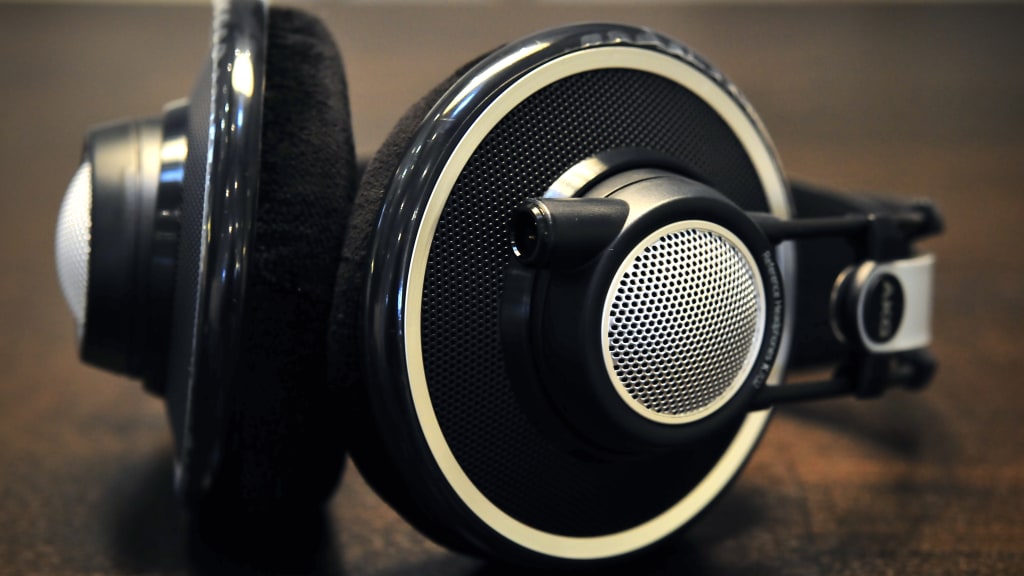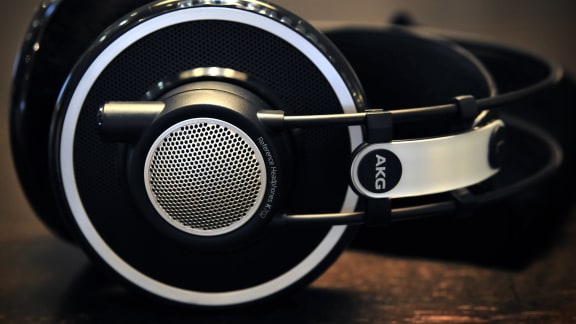AKG K702
18/12/2021
Author: Karsten Hein
Category: Gear & Review
Tag(s): Headphones
Similar to the nearly double-priced K712 Pro, the K702 were designed and engineered in Austria. But, instead of both models having been uniformly manufactured in Slovakia, the K702 were manufactured in China, which only served to highlight their low-price focus. Both headphones featured AKG’s patented flat wire voice coil for linear performance and increased responsiveness from 10 to 39.800 Hertz. Weighing in at a mere 290 grams, the K702 were 10 grams lighter than the K712 Pro — with neither model weighing the 235 grams promised on the packaging and in product reviews online. I guess nobody actually took the time to weigh them again once they were in production. The pictures show the K702 with protective plastic around their edges, because I had already decided to return them to the dealer at the time of taking the photos.
Both headphones were of the same open design and, by means of AKG’s patented two-layer diaphragm, offered extended frequency range and a spacious and airy sound. Whereas the K712 came with one spiralled and one straight orange cord, the K702 were equipped with a single straight and black cord. The mini-XLR connectors were the same on both units. This made it easier for me to change between the models during my listening tests. The colour scheme was different between them, too, with the K702 coming in (retro-)silver and black and the K712 Pro in orange and black. At first glance, I preferred the retro-silver design, as it looked more solid, but holding them in my own hands and realising that nearly all parts were of painted plastic, I found the orange to be more sincere.
It also found it interesting to read that both units came with pre-selected and matched transducers for improved performance consistency, and that each pair of headphones had been individually tested and numbered to assure for high quality following production. It seems that weighing them to assure that all parts had been included was not a part of this process at either factory location. It also seemed that the K712 Pro had been deliverd to another customer’s house for testing before coming to me, as the warranty instructions were no longer packaged in their original plastic sachet, and the protective seals around the ear pieces had already been removed. Neither pair of headphones seemed to have been designed to stand the test of time with the materials used being relatively thin and therefore seemingly fragile. AKG was no different in this respect from other companies, and yet it was never easy for me to acknowledge this trend. To prove my point, some customer reviews had already suggested online that there could be problems with individual channels loosing their connection. Another complaint had been about the sonic effect of the removable headphone plug and cord brushing over clothes. Although it was true that touching and rubbing the cable produced an unpleasant sound, I had no problems staying clear of my clothes and shoulders.
The K702 had received excellent reviews in the press for their highly revealing trans-lucid sound and excellent dynamics when they first came out at the end of 2008. Considering their entry-level price, I could easily agree with AKG that these were a pair of excellent headphones and would be useful “for precision listening, mixing, and mastering”. Their sound was light and agile, catching lots of transients and ambient noise. Perhaps this came at the cost of losing some of the lower end of the music. I had often found that it was relatively easy for equipment to sound revealing, as long as the lower aspects of the frequency band were omitted from the equation. If the eardrums were not too busy following the bass lines, there was more room for them to catch the detail at the top-end. It is a magic trick, as each one of us only has a single set of eardrums after all.
Comparing bass lines to natural instruments was not an easy feat with either one of the two headphones. The K712 Pro compensated for the natural bass-loss from their open-back design by raising lower-end frequencies by 3 dB. This was also not quite natural and correct, of course, because bass extension from loudspeakers came from room-interaction and the overlapping of frequencies, effects that were practically non-existent in the case of open headphones. However, I had some trouble with the ‘non-existing bass’ from open headphone designs being described as ‘honest’, because it was mostly the phenomenon of bass drop-off on open headphones, an issue to be addressed. From my experience with our Canton Vento 890 DC loudspeakers, many years earlier, I knew that over-accentuated highs and recessed lows - while perhaps interesting and exciting at first - could permanently spoil the listening pleasure.
And this was also the main reason for my decision to keep the more balanced K712 Pro headphones and to send back the bargain-priced K702 to the dealer. And, yes, I could also hear that the additional bass on the K712 Pro made them sound slightly less revealing and thickened singers’ vocals a little. However, I could appreciate this weightier sound as being more balanced and rounded. It certainly resembled more closely the sounds captured of all our speaker recordings and came closer to my understanding of live music. This is not to say that the K702 reproduced vocals wrongly. Singers simply sounded as if they had lost a few pounds in weight. And for listeners finding pleasure in an abundance of detail and a more penetrating presentation, the K702 will surely be the better choice.
AKG Company History
The Akustische und Kino-Geräte Gesellschaft m.b.H. was founded by Rudolf Hörige and Ernest Pless in Vienna, Austria in 1947. Rudolf was a physicist, and Ernst Pless was an engineer. The two men grouped their understanding of materials and mechanics to create loudspeakers, film projectors, and light meters. With the growing demand for media applications, AKG’s first microphone was used by Austrian radio stations, theatres, and Jazz clubs.
AKG achieved an international reputation for building excellent microphones with the launch of their D12 in 1953. This was far ahead of its time, and subsequent updates served to maintain its position. AKG also produced turntable cartridges during the 1970s and 80s.
The company established an American subsidiary in Los Angeles in 1985 and was taken over by the Harman group in 1994, which also operates Crown Audio. In 2017 the company facilities in Vienna (headquarters, manufacturing and engineering) were closed with most of Harman’s production facilities having been relocated to low-cost countries. At the time of writing this, Harman with its many brands is owned by the Korean conglomerate Samsung.
Specifications
- Driver type: patented 2-layer diaphragm, dynamic
- Design: over-ear, open
- Frequency range: 10 - 39.800 Hz
- Nominal impedance: 62 Ohms
- Sensitivity: 105 dB (1mWatt, 1.000 Hz)
- Power rating: 200 mWatts, max.
- Cables: 1x straight
- Connector: detachable via mini-XLR
- Cable length(s): 3m
- Plugs: 3.5mm + 6.3 mm jack
- Place of manufacture: China
- Weight: 290g (without cable)
- Year: 2008 - 2021





